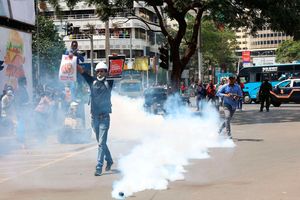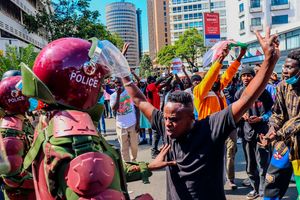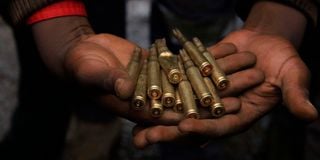
A protester displays spent cartridges used by police to disperse anti-government protesters in Karatina town, Nyeri County on July 16, 2024.
Fifty. That is the landmark death toll crossed on Tuesday. Sons and daughters, brothers and sisters, friends and loved ones killed since the start of the anti-government protests a month ago.
Most of the deaths have been attributed to excessive use of force by police in dealing with the largely youthful protestors, according to the Kenya National Commission on Human Rights (KNCHR).
Fifty. The fifty shilling Kenyan bank note is red in colour. An unwitting metaphor for the bloodletting that Kenyan authorities have visited on the country’s young demonstrators, aptly captured as one of the colours of the national flag emblemising the colonial government-instigated State of Emergency in the 1950s.
Fifty. If one were to number every name of the dead as per the alphabet, they would be just two shy of running twice over from A to Z. Some of their names, as listed by the Independent Policing Oversight Authority (Ipoa), make for a sobering reading.
Rex Kanyike Masai. Evans Kiratu. Ibrahim Kamau Wanjiku. Erickson Kyalo. David Chege. Wilson Sitati. Kelvin Odhiambo Maina. Kenneth Njeru Mwangi. Andrew Mwawasi. Kennedy Onyango.
Then there is Denzel Omondi, the Jomo Kenyatta University of Agriculture and Technology student whose body was recovered from Juja Dam, among many others.
1974. The year one would end up if they were to go back 50 years for every life lost; when Jomo Kenyatta was President and when something called Watergate scandal led to the resignation of a US president.
Fifty. If all of them were to be buried in one piece of land, with each grave covering three-by-eight feet of land, and with no spaces left in between, it will require 1,200 square feet of land — an area that can hold seven-and-a half shipping containers.
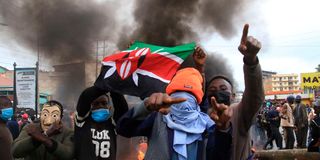
Anti-government protesters in Karatina town, Nyeri County, on July 16, 2024.
But no, this is beyond shipping containers. It is dreams shipped to the world beyond. Burning ambitions extinguished abruptly and with no room for appeal. University studies sent six feet under before the powers to read are conferred. Young people lying under the sod before they could see the new Kenya they were fighting for. Coffins of young Kenyans lowered while draped in the Kenyan flag as mourners seethe.
The numbers have been piling up since June 18 when the provisions of the Finance Bill, 2024, stirred anger across the country. On the very first day of protests, it emerged that the most riled were the Kenyans just entering their prime — the Generation Z, or simply Gen Z.
Now, the protests have added another letter. It is not just “Z” but now there is an “L”. L for 50 in Roman numerals. L for losses, senseless losses of life. L for lack of coordination in the security agencies that only caused more deaths. L for loaded guns that were pointed at unarmed protesters, releasing rounds of L for live bullets.
L for lies that government officials have been spreading aiming to understate the impact of the protests. L for lycanthropy. The word refers to transformation of human into animals, especially wolves, and that is what the security agencies have turned into as they torture young Kenyans while seeking information regarding the protests.
The youth prided themselves as being leaderless, tribeless, fearless. They stepped out with their flags, bottles of water, and whistles. Plus phones to capture the on-goings. Teargas would be lobbed their way, but they had the audacity to demand for a better flavour.
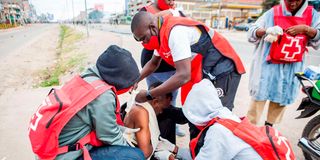
Red Cross personnel attend to an injured protester during the anti-government protests along Namanga Road in Kitengela on July 16, 2024.
The usual pepper-ish one was getting a tad too monotonous, they said. They looked police water cannons in the eye, and were perhaps inspired by the words of the late Martin Luther King Jr, one of the masters of non-violent protests, who once said that there is a fire that no water can put out.
Then it dovetailed into an “Occupy” movement. Occupy Parliament. Occupy State House. Occupy Everywhere. And occupy they did, though they kept losing their numbers.
Claims of infiltration arose. Allegations of planted goons abounded. As that progressed, the deaths kept piling up. Reports of high-handedness swelled. Nairobi CBD. Rongai. Githurai. The deaths ticker kept counting. One, two, three, four, five…up to fifty and counting.
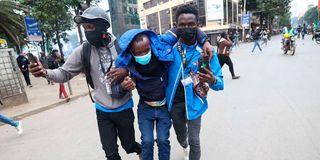
A man is assisted after being injured during the anti-government protests in Nairobi on July 16, 2024.
In a statement yesterday, KNCHR said 21 of the dead are from Nairobi, Nakuru (3), Laikipia (2), Narok (1), Kajiado (3), Uasin Gishu (4), Kakamega (2), Kisumu (3), Kisii (1), Mombasa (3), Siaya (1), Kiambi (1), Nandi (1), Embu (1), Homa Bay (1), Nyeri (1) and Bungoma (1). These numbers were set to increase as gunshots and fatalities were reported across the country following yesterday’s protests. Kitengela, Makueni and Nakuru were among the areas where gunshots were reported.
The Constitution-created human rights agency said it would be seeking to pin down police bosses over the excesses witnessed.
“The commission shall pursue command responsibility for all documented instances of police brutality and excesses,” said KNCHR.
“We also call upon His Excellency the President to honour his commitment to respecting the rule of law by issuing a zero-tolerance directive on human rights violations to all the deployed security agencies.”
The Interior Ministry also issued an unsigned statement titled “The sanctity of human life must be respected”. Its subject should have been “Yes, we killed” but that was buried inside the fine print.
One of its paragraphs read: “While the police are guided by the National Police Service Act which prohibits the use of excessive force in the execution of their duties, Section 49 of the Police Service Act allows the security officers to use force only when it is necessary and to the extent required in the execution of their duties.”
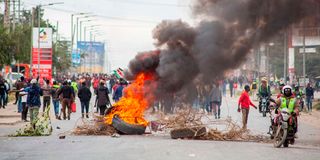
Protesters barricade Namanga Road with a bonfire during the anti-government protests in Kitengela on July 16, 2024.
“Security agencies are under instruction to exercise restraint during peaceful protests and use of non-lethal force to ensure public safety. The police can indeed be compelled to use reasonable force when isolated and specific scenarios of protests escalate to criminalities including rioting, looting and burning of properties, disruption of traffic through erection of roadblocks on major highways and invasion of critical and protected infrastructure,” it added.
The Interior Ministry further noted that what began as an expression of divergent opinion over the financial vision for the country “has tragically escalated to a situation where we are sadly counting the number of lives lost”.
Yes, counting. Fifty and counting. Fifty would make two full soccer teams for a World Cup match (of 23 each that comprise the starting 11 and 12 substitutes) and get four players to spare.
Fifty. President William Ruto’s official car has a capacity of seven passengers. If each of the dead Kenyans were to take a ride in such a car, it would require a motorcade of eight cars to accommodate them.




